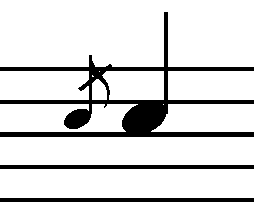Flams are a bit different to our other rudiment categories as they aren't built from a roll played with a specific sticking. A flam is a 'grace note', which is a small decorative note that falls just before a beat but doesn't count rhythmically. As with all rudiments, there are many reasons to spend time learning this. This is a very easy rudiment to throw into your playing and it will make your parts sound really cool with minimal effort.
In this first flam lesson you are only going to be playing the rudiment as crotchets and quavers to allow you to get comfortable with the sticking. When notated a flam looks like this:

Notice that the note before the crotchet beat is far smaller and has a dash through the tail of the note? The sound created is two snare hits being played at the same time but slightly displaced, it's pretty straight forward to do but might take a little practice to perfect.
We want the crotchet beat of the flam to be pretty loud and the flammed note (or grace note) to be a little softer and to achieve this you can take advantage of stick heights. The left hand will play the grace note and will start close to the snare drum skin while the right hand will be playing the crotchet beat and will start at a normal height. When you bring the two down at the same speed they will hit very slightly apart, creating a flam.
You will be learning three stickings for the flam and all are shown as quarter and eighth notes. In the first the right hand plays the crotchet, the second the left plays the crotchet and in the third you alternate. These are all shown below. Notice that the first note of the flam has the sticking written in lower case letters to indicate it is softer.
Exercise 1
A Flam in standard sticking as crotchets.

Exercise 2
A Flam in reversed sticking as crotchets.

Exercise 3
A Flam in alternate sticking as crotchets.

Exercise 4
A Flam in standard sticking as quavers.

Exercise 5
A Flam in reversed sticking as quavers.

Exercise 6
A Flam in alternate sticking as quavers.

TASK
- Using the 2 minute rule, get all 6 exercises up to a tempo of 135bpm.
- Experiment with orchestrating the rudiment.
- Experiment with adding feet to the rudiment.
- Experiment with applying the rudiment to fills.
Related lessons.

